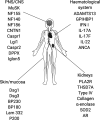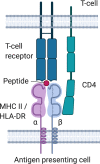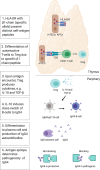Common Denominators in the Immunobiology of IgG4 Autoimmune Diseases: What Do Glomerulonephritis, Pemphigus Vulgaris, Myasthenia Gravis, Thrombotic Thrombocytopenic Purpura and Autoimmune Encephalitis Have in Common?
- PMID: 33584677
- PMCID: PMC7878376
- DOI: 10.3389/fimmu.2020.605214
Common Denominators in the Immunobiology of IgG4 Autoimmune Diseases: What Do Glomerulonephritis, Pemphigus Vulgaris, Myasthenia Gravis, Thrombotic Thrombocytopenic Purpura and Autoimmune Encephalitis Have in Common?
Abstract
IgG4 autoimmune diseases (IgG4-AID) are an emerging group of autoimmune diseases that are caused by pathogenic autoantibodies of the IgG4 subclass. It has only recently been appreciated, that members of this group share relevant immunobiological and therapeutic aspects even though different antigens, tissues and organs are affected: glomerulonephritis (kidney), pemphigus vulgaris (skin), thrombotic thrombocytopenic purpura (hematologic system) muscle-specific kinase (MuSK) in myasthenia gravis (peripheral nervous system) and autoimmune encephalitis (central nervous system) to give some examples. In all these diseases, patients' IgG4 subclass autoantibodies block protein-protein interactions instead of causing complement mediated tissue injury, patients respond favorably to rituximab and share a genetic predisposition: at least five HLA class II genes have been reported in individual studies to be associated with several different IgG4-AID. This suggests a role for the HLA class II region and specifically the DRβ1 chain for aberrant priming of autoreactive T-cells toward a chronic immune response skewed toward the production of IgG4 subclass autoantibodies. The aim of this review is to provide an update on findings arguing for a common pathogenic mechanism in IgG4-AID in general and to provide hypotheses about the role of distinct HLA haplotypes, T-cells and cytokines in IgG4-AID.
Keywords: HLA class II; HLA-DQB1; HLA-DRB1; IgG4 autoimmune disease; MHC; autoimmunity; etiology.
Copyright © 2021 Koneczny, Yilmaz, Lazaridis, Tzartos, Lenz, Tzartos, Tüzün and Leypoldt.
Conflict of interest statement
JT and ST have shares in the research and diagnostic laboratory Tzartos NeuroDiagnostics, Athens. FL discloses having received speaker honoraria from Grifols, Teva, Biogen, Bayer, Roche, Novartis, Fresenius, travel funding from Merck, Grifols, and Bayer and serving on advisory boards for Roche, Biogen, and Alexion. The remaining authors declare that the research was conducted in the absence of any commercial or financial relationships that could be construed as a potential conflict of interest.
Figures





Similar articles
-
A systematic review and meta-analysis of HLA class II associations in patients with IgG4 autoimmunity.Sci Rep. 2022 Jun 2;12(1):9229. doi: 10.1038/s41598-022-13042-2. Sci Rep. 2022. PMID: 35654912 Free PMC article.
-
Update on IgG4-mediated autoimmune diseases: New insights and new family members.Autoimmun Rev. 2020 Oct;19(10):102646. doi: 10.1016/j.autrev.2020.102646. Epub 2020 Aug 13. Autoimmun Rev. 2020. PMID: 32801046 Review.
-
IgG4 Autoantibodies in Organ-Specific Autoimmunopathies: Reviewing Class Switching, Antibody-Producing Cells, and Specific Immunotherapies.Front Immunol. 2022 Mar 24;13:834342. doi: 10.3389/fimmu.2022.834342. eCollection 2022. Front Immunol. 2022. PMID: 35401530 Free PMC article. Review.
-
Relation of HLA-DRB1 to IgG4 autoantibody and cytokine production in muscle-specific tyrosine kinase myasthenia gravis (MuSK-MG).Clin Exp Immunol. 2019 Aug;197(2):214-221. doi: 10.1111/cei.13302. Epub 2019 Apr 12. Clin Exp Immunol. 2019. PMID: 30929252 Free PMC article.
-
A New Classification System for IgG4 Autoantibodies.Front Immunol. 2018 Feb 12;9:97. doi: 10.3389/fimmu.2018.00097. eCollection 2018. Front Immunol. 2018. PMID: 29483905 Free PMC article. Review.
Cited by
-
Investigation of comorbid autoimmune diseases in women with autoimmune bullous diseases: An interplay of autoimmunity and practical implications.Int J Womens Dermatol. 2022 Oct 7;8(3):e053. doi: 10.1097/JW9.0000000000000053. eCollection 2022 Oct. Int J Womens Dermatol. 2022. PMID: 36225612 Free PMC article. Review.
-
Utility of IgG4 immunohistochemistry detection in pemphigus diagnosis.SAGE Open Med Case Rep. 2022 Jan 19;10:2050313X211072982. doi: 10.1177/2050313X211072982. eCollection 2022. SAGE Open Med Case Rep. 2022. PMID: 35070321 Free PMC article.
-
Short- and Long-Lived Autoantibody-Secreting Cells in Autoimmune Neurological Disorders.Front Immunol. 2021 Jun 17;12:686466. doi: 10.3389/fimmu.2021.686466. eCollection 2021. Front Immunol. 2021. PMID: 34220839 Free PMC article. Review.
-
Vulvar Lichen Sclerosus from Pathophysiology to Therapeutic Approaches: Evidence and Prospects.Biomedicines. 2021 Aug 3;9(8):950. doi: 10.3390/biomedicines9080950. Biomedicines. 2021. PMID: 34440154 Free PMC article. Review.
-
New Insights on DR and DQ Human Leukocyte Antigens in Anti-LGI1 Encephalitis.Neurol Neuroimmunol Neuroinflamm. 2023 Mar 27;10(3):e200103. doi: 10.1212/NXI.0000000000200103. Print 2023 May. Neurol Neuroimmunol Neuroinflamm. 2023. PMID: 36973076 Free PMC article.
References
Publication types
MeSH terms
Substances
Supplementary concepts
Grants and funding
LinkOut - more resources
Full Text Sources
Other Literature Sources
Medical
Research Materials

